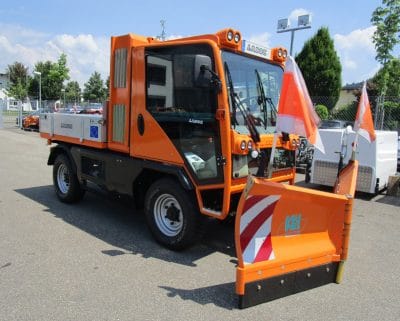To improve quality of life, a growing number of local councils have set up zones for environmental protection and noise reduction and have discussed driving bans to clean up the air in cities and metropolitan areas. One consequence of their efforts has been a tightening of emission regulations regarding community vehicles and public equipment. In response, researchers conceived a project named ELAAN to build an electric engine that is powered by fuel cells and batteries. The aim was to identify output requirements, map out a drive system, design fuel cell and battery modules, and integrate all components into a prototype. Computer models were employed to help draw up specifications and simulate operational modes.
Internal combustion engine vehicles must comply with ever-lower emission limits nowadays. Additionally, high noise levels, such as those caused by street sweepers and garbage trucks in the early morning hours, are often a serious impediment to quality of life, especially in metropolitan areas. One solution to these problems is the combined battery and fuel cell drive system that has been developed as part of ELAAN.
The system is nearly inaudible, while its only emission is water vapor. The use of hydrogen means that a high amount of energy can be stored in the tank of a vehicle and yet fueling takes little time. Batteries provide supplemental power and increase round-trip efficiency by harnessing kinetic energy.
However, it needs economies of scale to create a competitive engine. To lower costs, the system was designed with multiple applications in mind. One target market is industrial trucks, to which fuel cells are far more suited than batteries. This is particularly true if vehicles are required across three shifts, since their tanks can be filled up in a matter of minutes. Fast fueling is indeed the primary reason for the enormous popularity of hydrogen-powered industrial trucks in the United States, where the number of units ordered or shipped to customers has grown to more than 16,000 since 2009 [1].
Analyzing requirements
To size the electric motor and the fuel supply unit, initial analysis involved driving a conventional LADOG T-1250 vehicle along a predetermined route. The objective was to identify the maximum and continuous power output of the standard model, which is equipped with a 74-kilowatt four-cylinder diesel engine, along with the amount of energy required for day-to-day operation. To determine the mechanical power that is transferred through a hydrostatic drive to all four wheels of the car, the instant fuel consumption and engine torque values recorded during the test drive were multiplied with brake-specific fuel consumption and hydrostatic efficiency:
…
read more – subscribe H2-international
Written by: Stefan Keller M.S., Kläre Christmann M.S. and Adrian Heuer M.S.
All for Fraunhofer-Institut für Solare Energiesysteme ISE, Freiburg, Germany


























0 Comments